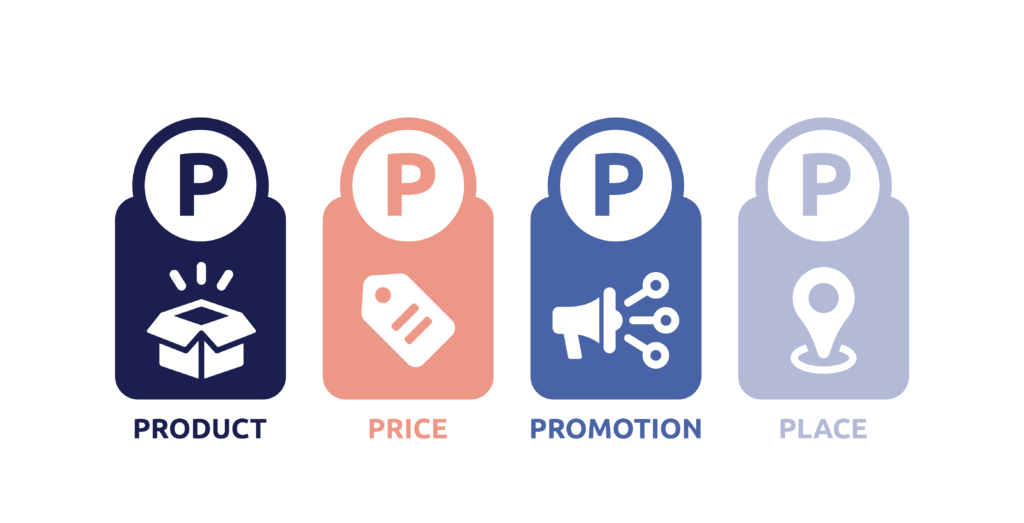When marketing a product or service, you need to present its unique selling points to show how it meets customers’ needs better than anything that has come before. This involves a wide range of considerations — and it can be difficult to know where to start to ensure you’ve covered everything. A solution that solves this predicament is marketing mix. It defines the elements you need to include in your marketing in an easy-to-remember way: the four Ps of marketing. These are product, price, place, and promotion. They allow you to assess customers’ needs and how your offering meets these needs, examine what customers think of your offering, reveal how you should be engaging with customers, and evaluate how you stack up compared to competitors.
Let’s look at each of the four Ps in turn to understand what they mean and how to use them.
Product
Although the first criterion is “product.” (This is to keep in the theme of the Ps; it can also refer to a service.) As well as the offering itself, “product” encompasses your brand, customer service, and packaging or how you present your offering.
To see high sales, your product should either meet an existing customer need (such as by solving a problem) or reveal a problem that customers never even knew they had. You’ll need to assess if your product has all the features required to meet these needs by considering how and when customers will use the product. Plus, you should consider if there are any unnecessary features that make the product less appealing to customers or make it more expensive to produce.
Even if you feel relatively confident that you know what customers want, you should still ask them. This can be as simple as posing a question or setting up a poll on social media, but you could also send out a full survey. Question customers about their opinions and ask open-ended questions to find out what problems they are facing, what they’re looking for, and where competitors’ solutions are falling short.
Price
It can be difficult to figure out the perfect price to charge for your product. You’ll need to decide what kind of profit margin you want, taking into account all the costs related to producing and selling the product. You’ll also need to determine if you want to offer any discounts and special offers, whether you’ll have a credit policy, and who these will be available to — perhaps just a certain segment of your audience.
In addition, you’ll need to consider how price changes the way customers perceive your brand and what kind of demand to expect for the product. Setting a high price can help frame your product as luxury or exclusive. In contrast, lowering the price makes it accessible to a wider audience.
Finally, it’s important to consider your current offerings and similar products from competitors. If your product is completely novel or you already dominate the market, you may be able to charge a premium. However, if there are already a large number of products similar to yours, low pricing can help you stand out.
How price-sensitive your customers are also has a role to play. There’s no need to necessarily beat your competitors’ prices. It’s possible that customers won’t notice if your product is slightly more expensive than those of your competitors, allowing you to see higher profit margins. Alternatively, customers may be sensitive to even the smallest decrease. In this case, lowering your prices may allow you to gain a greater share of the market.

Place
By place, we mean where the product will be available to purchase. This could be a brick-and-mortar store or online. If it’s online, you have the options of your own store, an ecommerce platform, or a combination of these. Alternatively, you may prefer to sell through a third party. In this case, you’ll need to find a way of connecting with potential sellers. Options include attending trade shows, sending samples to catalog companies, and joining a platform as a wholesaler. In any case, it’s key that you’ll be reaching customers where they are, rather than expecting them to go where you want them.
To decide on the most appropriate places to sell, you’ll need to know about your target audience’s preferences and behavior. This includes what types of devices they use to access the internet, where they live, and their shopping habits. If you’re already offering products, assess which channels are working best. Lastly, look at where your competitors are selling and think about what you can learn from that.
Promotion
Lastly, we have how you’ll promote your product: the strategies you’ll use for marketing, advertising, and publicity. In other words, promotion considers how you’ll use various channels for communication to encourage customers to purchase your product. It also looks at how effective these channels are.
Of all the four Ps, promotion is the one marketers think about the most these days, due to the growth of digital marketing. Plus, promotion is easier and more affordable than ever, as you can reach customers where they are with personalized messages. However, promotion is only useful if it’s actually resulting in conversions and ultimately generating revenue.
You’ve already considered where your target customers shop; you can use much the same process to figure out where users go to find out more information about products, brands, and your industry as a whole. This could include websites, social media, and email newsletters. Also consider which of these tend to be the most effective for promoting your message. Remember, this could differ according to where a user is in the buyer’s journey and whether your product has an extra appeal at a particular time of year.
A useful starting point is to look at what your competitors are doing. For instance, check if customers are engaging with them on various social media platforms, which keywords they are ranking for, and what kinds of ads they are running. Whereas your own target audience will not be exactly the same, running a competitor analysis is key, as it will show you potential opportunities and give you other valuable insights.
Applying the Four Ps
An important thing to bear in mind when using the four Ps is that they are all part of the marketing mix: they work together. It’s no good neglecting one and focusing your attention on another — this will jeopardize your entire strategy. You can cover each of the Ps in any order you wish, just make sure you always cover all of them.
To apply the four Ps, use this following method.
Step 1: Choose a Product to Assess for the Four Ps
It’s important to consider just one offering at a time — and work through all the criteria above.
Step 2: Ask Yourself What Would Happen If You Did Something Differently
What would happen if you changed a feature, increased the price, sold in another location, or marketed the offering on another channel? You may need to do market research to find out the answer. This is important to ensure your strategy is on the right track.
Step 3: Test Each of the Four Ps on Customers
Evaluate if the product meets customers’ needs, if it’s available where they want to purchase, if they are willing to pay the price you set, and if they like being reached through the promotional channels you’ve chosen.
Step 4: Use Customer Feedback to Make Changes
Once you’ve done this, test again. Only once you feel there’s no room for improvement should you bring your product to market.
Step 5: Return to the Four Ps on a Regular Basis
This final step is important because customers’ needs and wishes change with the product life cycle and as more competitors enter the scene.
Working on the four Ps may mean your team is overwhelmed by all the additional work the marketing mix involves. You can take some strain off your employees by contracting a virtual assistant. When you choose MYVA360, you’ll receive a dedicated virtual assistant who will take on all the tasks you lack the time to do yourself. You’ll also have access to our extended team for support with your digital marketing strategy. Schedule a consultation to receive a 10-percent discount.





